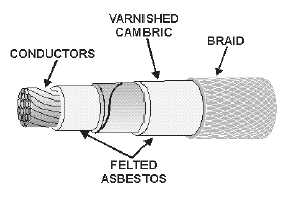1-18
Another type of asbestos-covered cable is shown in figure 1-10. It is combination of asbestos and
varnished cambric. This type of insulation serves as leads for motors and transformers that sometimes
must operate in hot, damp locations. The varnished cambric covers the inner layer of felted asbestos. This
prevents moisture from reaching the innermost layer of asbestos. Asbestos loses its insulating properties
when it becomes wet. It will, in fact, become a conductor. Varnished cambric prevents this from
happening because it resists moisture. Although this insulation will withstand some moisture, it should
not be used on conductors that may at times be partially immersed in water. Under those circumstances,
the insulation must be protected with an outer lead sheath.
Figure 1-10.—Asbestos and varnished cambric insulation.
The NEC has designators for eight types of asbestos wire. The designators and a description of each
are listed below.
Type A
Nonimpregnated asbestos without an asbestos braid
Type AA
Nonimpregnated asbestos with an outer asbestos braid or glass
Type AI
Impregnated asbestos without an asbestos braid
Type AIA
Impregnated asbestos with an outer asbestos braid or glass
Type AVA
Asbestos, varnish-cambric insulation with an outer asbestos braid or glass
Type AVL
Asbestos, varnish-cambric insulation with an outer asbestos braid covered with a lead
sheath
Type AVB
Asbestos, varnish-cambric insulation with an outer flame-retardant cotton braid
Type SA
Silicone rubber insulated with outer heavy glass, asbestos-glass, or asbestos braid
Q25.
State the reasons that the Navy is getting away from the use of asbestos insulation.
Q26.
State what happens to the insulating characteristics of asbestos when it gets wet.
Paper
Paper has little insulation value alone. However, when impregnated with a high grade of mineral oil,
it serves as a satisfactory insulation for extremely high-voltage cables. The oil has a high dielectric
strength, and tends to prevent breakdown of the paper insulation. The paper must be thoroughly saturated
with the oil. The thin paper tape is wrapped in many layers around the conductors, and then soaked with
oil.
The three-conductor cable shown in figure 1-11 consists of paper insulation on each conductor. It has
a spirally wrapped nonmagnetic metallic tape over the insulation. The space between conductors is filled
with a suitable spacer to round out the cable. Another nonmagnetic metal tape is used to secure the entire

